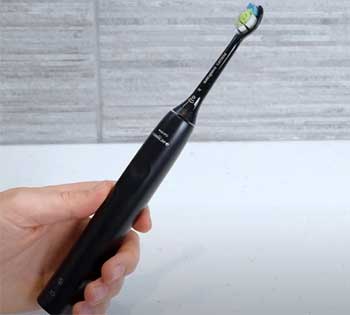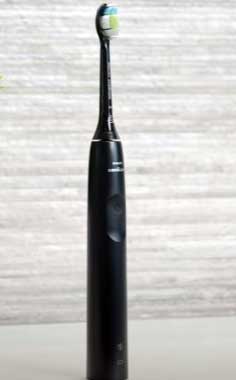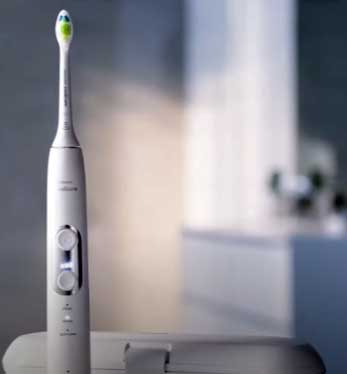I’ve been using electric toothbrushes for years, and I’ve tested my fair share of models, including the Philips Sonicare 4100 and 6100. Both are solid options, but they cater to slightly different needs.
In this article, I’ll break down their features, share my experience, and help you decide which one fits your oral care routine. From brushing modes to battery life, I’ll cover it all with a detailed comparison, pros and cons, and answers to common questions.
Let’s figure out which Sonicare is your perfect match.
A Brief Comparison Table
| Feature | Sonicare 4100 | Sonicare 6100 |
| Brushing Modes | 2 (Clean, Gentle) | 3 (Clean, White, Gum Care) |
| Intensity Settings | 2 (High, Low) | 3 (Low, Medium, High) |
| Brush Head | C2 Optimal Plaque Control | W DiamondClean |
| BrushSync Technology | Replacement Reminder | Replacement Reminder + Mode Pairing |
| Battery Life | ~17 days (High), ~5 weeks (Low) | ~3 weeks |
| Motor Movements | 31,000 strokes/min | 62,000 movements/min |
| Pressure Sensor | Vibration Alert | Vibration + Visible Light Ring |
| Travel Case | Not Included | Included |
| Price (Approx.) | ~$47.51 | ~$119 |
| Color Options | 3 (Varies by retailer) | 5 (White, Navy, Pink, Black, Silver) |
| Weight | 3.4 oz | 4.7 oz |
Why I Chose To Compare These Two Models?
When I decided to upgrade my oral care routine, the Philips Sonicare lineup caught my attention. The brand’s reputation for quality and innovation is hard to ignore, but with so many models, picking the right one felt overwhelming.
The Sonicare 4100 and 6100 stood out as popular choices in the mid-range category, offering a balance of features and price. I wanted to understand what sets them apart and whether the 6100’s extra features justify its higher cost.
After using both for weeks, I’m ready to share my insights to help you make an informed decision.
First Impressions of Philips Sonicare 4100 And 6100 Toothbrush

Opening the Sonicare 4100 box, I was struck by its simplicity.
It comes with a sleek handle, a C2 Optimal Plaque Control brush head, a USB charging base, and a brush head cover.
The design is minimalist, with a slim, lightweight handle (3.4 ounces) that feels comfortable in hand.
It’s straightforward, no-frills, and ready to use after a quick charge.
The Sonicare 6100, on the other hand, feels like a premium package. It includes a W DiamondClean brush head, a charging base with a 2-pin adapter, a sturdy travel case, and a slightly heftier handle (4.7 ounces).
The extra weight didn’t bother me, but I noticed the 6100’s design has a touch of elegance, especially in the navy color I tested. The travel case was a nice bonus for someone like me who’s often on the go.
Core Features: What They Share?
Both the 4100 and 6100 are built on Philips Sonicare’s signature sonic technology, which pulses water between teeth to break up plaque.
They both feature a 2-minute SmarTimer with a QuadPacer, buzzing every 30 seconds to guide you through each quadrant of your mouth. I found this feature incredibly helpful for ensuring even brushing, especially on days when I’m distracted.
Both models also have BrushSync technology for replacement reminders, alerting you when it’s time to swap out the brush head (typically every three months). The pressure sensor is another shared feature, though implemented differently, which I’ll cover later.
These core elements make both toothbrushes effective at plaque removal—up to 5x-7x more than a manual toothbrush, based on my research and experience.
Sonicare 4100: The Budget-Friendly Powerhouse
The Sonicare 4100 is the more affordable option, typically retailing around $47.51. It’s designed for those who want a reliable electric toothbrush without extra complexity. Here’s what I noticed after using it for a couple of weeks.
- Brushing Modes and Intensity

The 4100 offers two modes: Clean and Gentle.
The Clean mode is the default, delivering a standard 2-minute cycle that feels powerful yet comfortable.
The Gentle mode reduces intensity, which I appreciated on days when my gums felt sensitive after eating acidic foods like citrus.
You can toggle between two intensity settings (High and Low) by pressing the power button.
The High setting uses the full 31,000 strokes per minute, while the Low setting feels about half as intense, making it ideal for beginners or those with sensitive teeth.
- Brush Head and Cleaning Performance
The C2 Optimal Plaque Control brush head is a standout. Its high-quality bristles and curved power tip target hard-to-reach areas, like behind my molars.
During testing, I used a plaque-disclosing tablet to check its effectiveness, and the 4100 removed most of the pink stains, leaving my teeth feeling smooth and clean. It’s not perfect—some plaque lingered on the inner surfaces of my lower teeth—but it outperformed any manual toothbrush I’ve used.
- Battery Life and Charging
Philips claims the 4100 lasts two weeks on a single charge, but I got about 17 days on the High setting and over five weeks on the Low setting. The USB charging base is compact, but it requires an adapter for two-prong outlets, which wasn’t included in my box.
This was a minor inconvenience, but I had a spare adapter at home.
- Pressure Sensor and Ergonomics
The 4100’s pressure sensor vibrates the handle when you brush too hard. I found it effective, though it took a few uses to recognize the subtle alert.
The slim handle is easy to grip, even without rubberized surfaces, and it’s simple to clean. At 3.4 ounces, it’s one of the lighter Sonicare models, which I appreciated during longer brushing sessions.
Pros And Cons of the Sonicare 4100
Pros
- Affordable price point (~$47.51).
- Lightweight and ergonomic handle.
- Effective plaque removal with C2 brush head.
- Long battery life, especially on Low setting.
- Simple operation with two modes and intensities.
Cons
- Only one brush head included.
- No travel case, which is a drawback for frequent travelers.
- USB charger requires an adapter for some outlets.
- Pressure sensor isn’t visible, which may be less intuitive.
- Fewer features compared to higher-end models.
Sonicare 6100: The Feature-Rich Contender
The Sonicare 6100, priced around $119, is a step up in terms of features and design. It’s aimed at users who want a more tailored brushing experience. Here’s my take after testing it.
- Brushing Modes and Intensity

The 6100 offers three modes: Clean, White, and Gum Care.
The Clean mode is similar to the 4100’s, providing a solid 2-minute cycle.
The White mode extends to 2 minutes and 30 seconds, focusing on stain removal, which I found effective for tackling coffee stains on my front teeth.
The Gum Care mode runs for 3 minutes, with an extra minute of lower-intensity brushing to massage gums.
I noticed a slight improvement in gum comfort after using this mode consistently.
The 6100 also has three intensity settings (Low, Medium, High), giving you more control. I mostly stuck with Medium, as High felt too intense for daily use, but the flexibility was nice for customizing my routine.
- Brush Head and Cleaning Performance
The W DiamondClean brush head is designed for whitening and plaque removal. Its compact shape and specially arranged bristles did a fantastic job of polishing my teeth, especially on the White mode.
In my plaque-disclosing test, the 6100 performed slightly better than the 4100, removing nearly all stains, including those tricky spots near my molars. The difference wasn’t night-and-day, but it was noticeable.
- BrushSync Mode Pairing
Unlike the 4100, the 6100’s BrushSync technology includes mode pairing. When you attach a specific brush head, the handle automatically selects the corresponding mode and intensity.
For example, snapping on a W DiamondClean head sets the brush to White mode. I found this feature convenient, as it eliminated guesswork, though I sometimes preferred manually selecting modes for flexibility.
- Battery Life and Charging
The 6100’s battery life is rated at about three weeks, which aligned with my experience (roughly 21 days). This is shorter than the 4100 on its Low setting but still respectable.
The 2-pin charger is more traditional than the 4100’s USB setup, which I preferred for its compatibility with standard outlets. The included travel case is a practical addition, keeping the brush and two heads protected during trips.
- Pressure Sensor and Design
The 6100’s pressure sensor is a step up, combining a vibration alert with a visible light ring at the handle’s base. This made it easier to notice when I was brushing too hard, especially during early morning routines when I’m half-awake.
The handle is slightly heavier at 4.7 ounces, but it feels sturdy and premium. With five color options, it’s also more stylish than the 4100’s three colors.
Pros And Cons of The Sonicare 6100
Pros
- Three brushing modes for tailored cleaning.
- Three intensity settings for greater customization.
- W DiamondClean brush head excels at whitening.
- BrushSync mode pairing simplifies operation.
- Includes a travel case and visible pressure sensor.
Cons
- Higher price (~$119) may not suit all budgets.
- Heavier handle could feel bulky for some.
- Battery life shorter than 4100 on Low setting.
- Replacement brush heads are expensive.
- Extra features may be unnecessary for basic needs.
Also Read: Is Quip 360 Oscillating Toothbrush Worth It?
Head-to-Head Comparison of Philips Sonicare 4100 And 6100 Toothbrushes
The Sonicare 4100 and 6100 differ in several key areas:
- Brushing Modes: 4100 has 2 (Clean, Gentle); 6100 has 3 (Clean, White, Gum Care).
- Intensity Settings: 4100 offers 2 (High, Low); 6100 offers 3 (Low, Medium, High).
- Motor Power: 4100 delivers 31,000 strokes/min; 6100 delivers 62,000 movements/min.
- Brush Head: 4100 uses C2 Optimal Plaque Control; 6100 uses W DiamondClean.
- BrushSync: 4100 has replacement reminders; 6100 adds mode pairing.
- Pressure Sensor: 4100 uses vibration; 6100 combines vibration and a visible light ring.
- Battery Life: 4100 lasts ~17 days (High) or ~5 weeks (Low); 6100 lasts ~3 weeks.
- Travel Case: 4100 lacks one; 6100 includes it.
- Price: 4100 costs ~$47.51; 6100 costs ~$119.
- Weight: 4100 is 3.4 oz; 6100 is 4.7 oz.
- Color Options: 4100 has 3; 6100 has 5.
After using both toothbrushes, the differences come down to features, performance, and value. The 6100’s motor delivers 62,000 movements per minute compared to the 4100’s 31,000 strokes per minute.
In practice, the 6100 feels slightly more powerful, but the 4100’s higher amplitude (the distance bristles move) makes its cleaning comparable. I didn’t notice a dramatic difference in cleanliness, but the 6100 edged out slightly in whitening and gum care.
The 6100’s extra modes and intensities are its biggest selling point. If you want a toothbrush that adapts to specific needs—like stain removal or gum sensitivity—the 6100 is more versatile. The 4100, however, is simpler, which I found appealing for quick, effective brushing without fussing over settings.
Price is a major factor. The 4100’s $47.51 price tag is budget-friendly, while the 6100’s $119 feels steep unless you value the extra features. The travel case and mode pairing on the 6100 are nice, but I didn’t miss them much with the 4100, especially since travel cases can be purchased separately.
Which One Felt Better?

Using the 4100 felt like driving a reliable sedan—simple, efficient, and gets the job done.
Its lightweight design and straightforward operation made it my go-to for daily brushing.
The Gentle mode was a lifesaver during a week when my gums were irritated from a new mouthwash.
The 6100, by contrast, felt like a luxury SUV.
The extra modes and intensities let me fine-tune my brushing, and the W DiamondClean head left my teeth noticeably shinier.
The visible pressure sensor was a game-changer for me, as I tend to brush too hard. However, the heavier handle and higher price made me question whether the upgrades were worth it for my routine.
Also Read: Comparison of Sonicare 4300 And 6100 Toothbrushes.
Who Should Choose The Sonicare 4100?
The 4100 is ideal if you’re new to electric toothbrushes, on a budget, or prefer simplicity. It’s perfect for:
- First-time electric toothbrush users.
- Those who want effective cleaning without extra features.
- Budget-conscious buyers looking for value.
- People with smaller hands or who prefer lighter handles.
I’d recommend it to anyone who wants a no-nonsense toothbrush that delivers excellent plaque removal and decent battery life without breaking the bank.
Who Should Choose The Sonicare 6100?

The 6100 suits those who want a premium experience with more customization. It’s best for:
- Users with specific needs, like whitening or gum care.
- Frequent travelers who value the included case.
- Those who enjoy tweaking settings for a tailored brush.
- People who prefer a visible pressure sensor for feedback.
If you’re willing to spend more for versatility and a sleeker design, the 6100 is a great choice.
Long-Term Considerations: Durability and Cost
Both models use rechargeable lithium-ion batteries, which Philips claims last for years. However, I’ve read user reports suggesting the 4100 may not last as long as the 6100, with some units failing after 1-2 years.
My 4100 is still going strong after six months, but my 6100 feels more robust due to its build quality.
Replacement brush heads are a significant ongoing cost. The C2 heads for the 4100 and W DiamondClean heads for the 6100 cost about $5-$10 each, depending on the pack size.
Since both models are compatible with all Sonicare heads, you can mix and match, but the 6100’s mode pairing works best with specific heads.
Which One Should You Buy?
After testing both, I lean toward the Sonicare 4100 for most people. Its affordability, lightweight design, and solid performance make it a fantastic value. The 6100’s extra features are nice, but unless you need the whitening or gum care modes, the 4100 gets you 90% of the way there for half the price.
If budget isn’t a concern and you love customizing your brushing, the 6100’s versatility and premium feel are worth considering.
Ultimately, your choice depends on your priorities. If you want simplicity and savings, grab the 4100. If you’re after a tailored experience and don’t mind the cost, the 6100 won’t disappoint. Either way, both will leave your teeth cleaner than a manual brush ever could.
Also Read: Comparison of Oral-B Pro 1000 And Philips Sonicare 4100.
Frequently Asked Questions (FAQ)
The 6100 offers more brushing modes, intensity settings, and a visible pressure sensor, making it more versatile. However, the 4100 is nearly as effective for basic cleaning at a lower price. It depends on whether you need the extra features.
Yes, the 4100 is excellent for most users. It provides powerful cleaning, a pressure sensor, and long battery life, making it a great value for everyday oral care.
The 4300 has one cleaning mode (Clean) and two intensity settings, while the 6100 has three modes (Clean, White, Gum Care) and three intensities. The 6100 also includes a travel case and mode pairing, while the 4300 has a simpler design.
Yes, differences exist in brushing modes, intensity settings, brush heads, and features like travel cases or mode pairing. However, core cleaning performance is similar across models, with higher-end ones offering more customization.
Conclusion: Your Smile, Your Choice
You’ve got two solid options with the Philips Sonicare 4100 and 6100, and I hope my experience helps you pick the right one. The 4100 is your best bet if you want an affordable, effective toothbrush that covers the essentials.
If you’re craving more control and a premium feel, the 6100’s extra modes and features might be worth the splurge. Whichever you choose, you’re investing in a cleaner, healthier smile. Let me know if you have more questions—I’m here to help you find the perfect brush!
